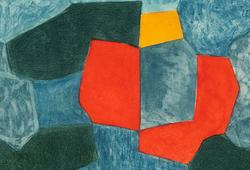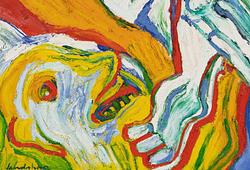Owe Zerge
Portrait of a young man reading
Signed Owe Zerge verso, Arkelstorp, Svezia. Likely executed in the early 1930s. Oil on panel 66 x 45 cm.
Provenance
Acquired at auction in Helsingborg, Sweden, around 2007.
More information
I Owe Zerge's portrait painting, realism is combined with a subtle impressionistic feel. In the auction's portrait, the classical portrait tradition is balanced with a more modern, stripped-down aesthetic. The artist has carefully rendered the model's physical appearance, his facial features, skin tones, and every strand of hair. In the more impressionistic depiction of the clothing, Zerge's sensitivity and interest in texture emerge. The brushstrokes evoke the fabric's velvety sheen and softness. The young man is portrayed in profile, which imparts a sense of dignity and timelessness.
According to classical portraiture, there are markers in the image that testify to the man's social standing and status, while the portrait also reflects his character. Zerge has skillfully captured a private moment of contemplation, while the viewers are kept slightly at a distance, as if to protect the young man's inner life.
Zerge grew up in the cottage Kullesta in Arkelstorp, which was nestled in a large and untouched garden. Inspired by his father's interest in portrait painting, Zerge moved to Stockholm to open his own studio while studying at Caleb Althin's painting school (1914–1915) and the Royal Academy of Fine Arts (1915–1919).
In 1920, he travelled to France, where he debuted at the Paris Salon in 1921. The journey continued to Italy for further studies, and Zerge lived for a time in a monastery in Tuscany. His time in Italy would influence him on several levels; he converted to Catholicism, he focused on and developed his material painting, and he became captivated by Italian garden art.
In 1931, Zerge bought back his old childhood home Kullesta, Arkelstorp at auction. He moved back home and created a beautiful garden inspired by his time in Italy. Owe Zerge had a remarkable ability to capture the individual's character and psychological expression, which made him a sought-after portrait painter, particularly within cultural circles.



















































